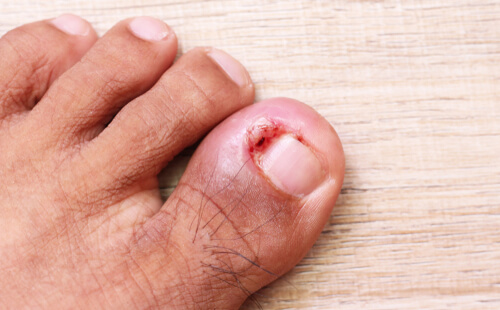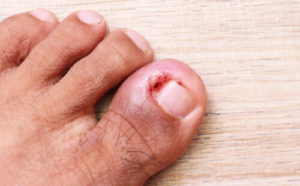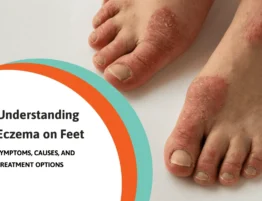
Ingrown toenails can be one of the most painful foot conditions one can experience. But did you know that ingrown toenails can sometimes be treated with home remedies? Here, we’ll discuss what you should do and when it is appropriate to seek professional attention for ingrown toenail treatment.
 What exactly is an ingrown toenail?
What exactly is an ingrown toenail?
As the name implies, you would assume the nail is cutting into your flesh and getting buried into the skin. However, this is not the case. It simply means the hard nail is being an irritant to the skin next to it and in some cases, it can actually cause a breakdown in your skin. If the toenail is not clean, it is likely that bacteria will get into the skin where the breakdown occurs.
What causes an ingrown toenail?
Tight fitting shoes could start the problem, so make sure you do not wear shoes that are too narrow or too short. Proper sizing is important.
Trauma – If you drop something heavy like a frozen turkey on your toenail it may cause it to injure the flesh around it, thus causing the nail to dig in. You could also lose the nail in which case it may grow back deformed and then grow in.
Congenital nails – Ingrown nails may be caused by genetics factors than most would expect. It is not uncommon to hear patients say they are getting an ingrown nail just like their dad did when he was their age.
Improper trimming – It’s important to be careful when trimming your nails. It is true that you should trim your nails straight across. However, you must be careful not to leave a sharp corner on the nail; it is okay to round that corner slightly in some cases. Also, trimming your nails too short should be avoided.
Fungus – A fungal infection of the nail can deform it. The nail can become more curved and grow in on the side. Or it may be thickened, and this can also cause more pressure in the middle or sides of the nail.
Foot deformities – If you have toes that deviate, such as a hammertoe or a bunion, the nail may grow in as a result of this. The big toe rubbing against the second toe in the case of a bunion, is a great example.
What should you do if you have an ingrown nail?
Early treatment is important. At first, if the pain is minimal with little to no redness along the side of the nail, you should start treatment. Here are some things you can do to control it:
Soak your foot in soapy water three to four times a day for 10-20 minutes. Dry your foot well and apply an antibiotic cream such as Neosporin.
Get out of your closed shoe as much as possible if it is possible.
Try to gently massage the skin, always from the nail edge. Using coconut oil would be ideal when you do this.
If it is just the tip of the nail edge digging in, you might be able to lift the nail up and use dental floss. It is important to consider using waxed floss.
When to seek medical attention?
If you made the attempts I have suggested, and the pain persists, then it is time to get a professional opinion on your ingrown toenail treatment. Also, there is no deadline as to when you can see the doctor. If your toe is very painful; either red, hot or draining pus, you must make sure you call your podiatrist. No amount of the home care I have suggested may help in this situation.
If you are a diabetic or have problems with poor circulation or have a medical condition that has negative effects on your nervous system, you must immediately see a doctor.
What will the doctor do at the office visit?
In a situation where the edge of the nail is digging, the nail edge may need to be removed. A portion of the nail border or borders may need to be removed. When the edge is removed, in most cases, a chemical is applied that kills the cells that form the nail. No sutures and incisions are used, and most patients do not take medication for pain. In most cases, the patient may go back to work the next day and can work full time.
There is a possibility of a fungal nail. If the nail is not infected and not as severe in many cases, treating the fungus may restore more normal nail growth and therefore reduce the thickness and nail deformity. There are several treatment options the doctor may speak to you about. This includes the use of topicals, oral medication or laser nail treatment. Of these three, laser nail treatment is the most successful. Be aware that not all podiatrists offer to do a laser treatment. So you may consider that when getting a professional opinion of your ingrown nail, especially if you have yellow,thickened and deformed nails.
Now that you know all about ingrown toenail treatment, you will have a more informed plan of action if this happens to you.

 What exactly is an ingrown toenail?
What exactly is an ingrown toenail?








Write a comment: